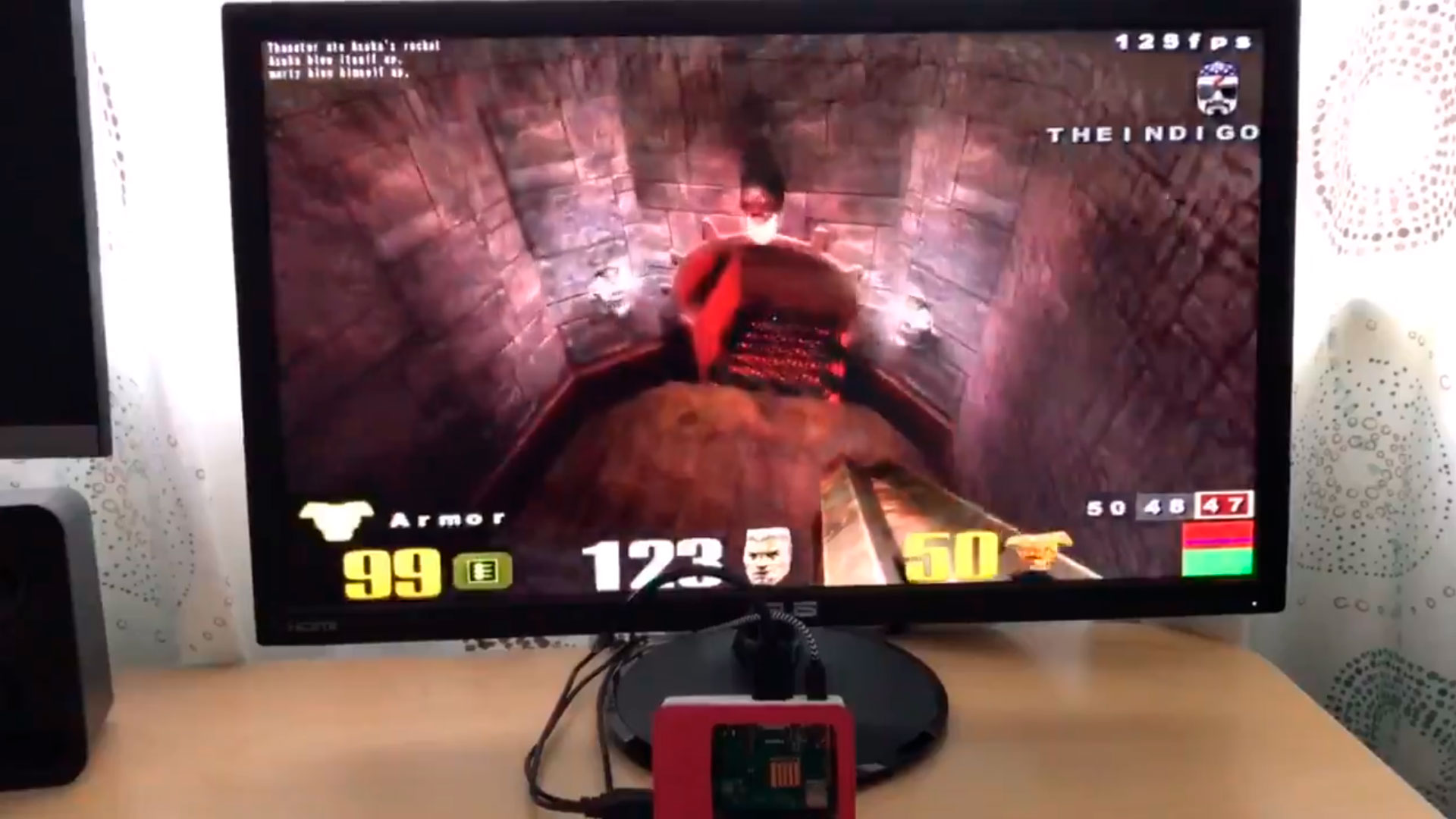Nvidia Engineer's Vulkan Driver For Raspberry Pi Runs Quake III Over 100 FPS at 720p

Earlier this year, the Raspberry Pi Foundation hooked up with Igalia to start development on an open-sourced Vulkan graphics driver for the Raspberry Pi. However, Martin Thomas, an engineer at Nvidia, beat them to the punch.
Thomas announced yesterday via his personal Twitter that his RPi-VK-Driver is ready for primetime. The talented engineer had been working on the Vulkan driver in his spare time for more than two years.
Technically, Thomas' iteration isn't a Vulkan driver per se because it doesn't comply with the official standards established by The Khronos Group. Nonetheless, the resourceful developer produced a driver that adheres to the Vulkan parameters as much as possible, and as close as the hardware would permit it. There's just one limitation with the RPi-VK-Driver though. Unlike the official Vulkan driver that's still in the works, Thomas' version is only compatible with the Broadcom VideoCore IV GPU that's found inside the Raspberry Pi 1, 2, 3 and Zero devices.
VkQuake3 running at 100+ FPS on a @Raspberry_Pi 3B+ using the new low level RPi-VK-Driver pic.twitter.com/UhhYgQrAEiJune 19, 2020
Thomas showed off the power of his RPi-VK-Driver with a Raspberry Pi 3 Model B+ and Quake III Arena. The Broadcom VideoCore IV GPU, which is clocked at 250 MHz, runs the title at over 100 FPS on the 1,280 x 720 resolution. Thomas estimated that the Raspberry Pi 3 Model B will likely deliver around 70 FPS at a 1,920 x 1,080 resolution due to the hardware limitation.
In comparison to the OpenGL drivers, Thomas affirms that his RPi-VK-Driver offers improved memory management, and it's better at handling multi-threaded command submissions. The driver's other attributes include MSAA (multisample anti-aliasing) support, low level assembly shaders and performance counters.
Get Tom's Hardware's best news and in-depth reviews, straight to your inbox.

Zhiye Liu is a news editor, memory reviewer, and SSD tester at Tom’s Hardware. Although he loves everything that’s hardware, he has a soft spot for CPUs, GPUs, and RAM.
-
bit_user I wonder how much of it runs on the CPU cores.Reply
In the Pi v4, anyhow, there's significantly more raw performance in them, than its GPU. I wouldn't be surprised if that was also true of the Pi 3. -
jeremyj_83 Considering Quake 3 came out in 1999 I don't consider this that big of an accomplishment to run at 100fps on 720p.Reply -
jtremblant Great news having a fully optimised low level OpenGL(vulkan) driver for an outdated hardware as Rpi 3. I'm buying online a Rpi 3B as we speak. I must test it out my fav game from id software, then rpi 3b will serve as a pi-hole server.Reply -
bit_user Reply
20 years is about how far back you have to go, in order to find high-end GPUs with weaker specs than the Pi's VideoCore. So, it actually makes sense that it would run such an old game so well.jeremyj_83 said:Considering Quake 3 came out in 1999 I don't consider this that big of an accomplishment to run at 100fps on 720p. -
jtremblant Back in 1998, my 3dfx voodoo video cards in SLI mode cost me $600 both, and still required a 2d video card to run($100). Yes, that's how much we paid to have nice accelerated graphics back in 1988-1999. BTW, that would be $1100 in today's money. Sadly, with the introduction of nvidia TNT($125) 1999 and TNT2 ultra($169) 2000 which had about 80% of a voodoo 2 performance in SLI mode, 3dfx company went to the drain. Soon after that TNT video cards were everywhere selling at only $80 Usd. I dislike nvidia for personal reasons and never bought a gaming video card from them in 21 years.Reply -
nobspls The more things change the more they stay the same. 20 year later we are back to Quake 3. Which begs the question, does all the expensive hardware, eye candy graphics, really make for a better game? Does better game play, game mechanics matter more?Reply
No doubt that all that computational horsepower, billions spend in development, and billions more spent by people for the hardware is worth something, and has good application for things raning from AI to crypto farming. In the big picture do people like games more because of the eye candy or do they like it more because of the game play, game mechanics, all the non technological aspects?
It seems like even with all this fancy ray-tracing stuff, and really good graphics capability, in the last 5 years there has been no really compelling game to really justify all that hardware. Instead you get more stupid developers taking away even some thing simple like co-op play thru the story mode. -
spongiemaster Reply
By the time Quake 3 was released in December of 1999, Voodoo 1 was over 3 years old and we had moved on to Voodoo3 earlier in the year which no longer supported SLI and didn't need an additional 2D card.jtremblant said:Back in 1998, my 3dfx voodoo video cards in SLI mode cost me $600 both, and still required a 2d video card to run($100). Yes, that's how much we paid to have nice accelerated graphics back in 1988-1999. BTW, that would be $1100 in today's money. Sadly, with the introduction of nvidia TNT($125) 1999 and TNT2 ultra($169) 2000 which had about 80% of a voodoo 2 performance in SLI mode, 3dfx company went to the drain. Soon after that TNT video cards were everywhere selling at only $80 Usd. I dislike nvidia for personal reasons and never bought a gaming video card from them in 21 years. -
jtremblant Reply
Voodoo 2 release date was february 1998, I bought mines in april 1998. Pretty Soon, AGP was introduced and that allow to have single 2D/3D video cards like Voodoo 3 3000 which I bought during summer of 1999(only 14 months after). PCI slot for video cards was already dying back in 1999-2000. Case in point, lifespan for video cards was very short due to implosion of new technologies during those years(dark ages of PC gaming). I remember back then, obsolescence would knock your door so quick that required a new PC build every 12 months, if you wanted to be able to play the latest game.spongiemaster said:By the time Quake 3 was released in December of 1999, Voodoo 1 was over 3 years old and we had moved on to Voodoo3 earlier in the year which no longer supported SLI and didn't need an additional 2D card. -
bit_user Reply
Voodoo 3 wasn't as big a jump over 2, as 2 was over 1. With Voodoo 2, 3Dfx literally doubled the performance of Voodoo 1 (more or less, depending on the use of multi-texturing).spongiemaster said:By the time Quake 3 was released in December of 1999, Voodoo 1 was over 3 years old and we had moved on to Voodoo3 earlier in the year which no longer supported SLI and didn't need an additional 2D card.
According to this, Voodoo 2-SLI setups often beat Voodoo 3: https://en.wikipedia.org/wiki/Voodoo3
Looking at the specs of all the unreleased models, it's a real shame that 3Dfx sank. If they hadn't bought STB, maybe they would be the dominant GPU maker, today.
https://en.wikipedia.org/wiki/3dfx_Interactive#Products